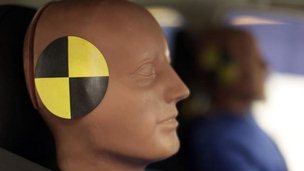
Cheap sensors that help cars avoid collisions could emerge from research into a lensless imaging system.
US scientists have used metamaterials to build the imaging system, which samples infra-red and microwave light.
Metamaterials are materials that have properties purposefully designed rather than determined by their chemistry.
The sensor also compresses the images it captures in contrast to current compression systems, which only squash images after they are taken.
Most imaging systems, such as those found in digital cameras, use a lens to focus a scene on a sensor studded with millions of tiny sensors. More sensors means more detail is captured and, generally, produces a higher resolution image.
The imaging system developed by graduate student John Hunt and colleagues at Duke University in North Carolina has no lens and instead combines a metamaterial mask or aperture and complicated mathematics to generate an image of a scene.
The aperture is used to focus different wavelengths of light in different parts of a scene onto a detector. The different frequencies in the scene are sampled sequentially.
This sampling helped to work out the distribution and mix of light wavelengths and their relative intensities found in a scene, said John Hunt.

“Then we use some very elegant maths which was developed in computational imaging to turn that data into a 2D picture,” he told the Science podcast. The wavelength sampling was done electronically so happens very fast, he added.
Currently the imaging system could capture about 10 images per second, he said. In addition, the imaging system compressed the information as it was gathered. Most other image compression systems, such as the widely used Jpeg format, are applied after an image has been snapped.
While imaging systems that capture infra-red and microwave wavelengths already existed, said John Hunt, they were typically expensive, bulky or complicated to build.
By contrast, the Duke imaging system used a thin strip of metamaterial mated with some electronics and processing software. Although it did not yet work with visible wavelengths of light, John Hunt said it could lead to a range of cheap, small, portable sensors that could find a role in many different fields.
“You could build an imager into the body of a car to do collision-avoidance imaging, or you could have a cheap handheld device to look through walls for wires and pipes,” he said.
A research paper detailing the work has appeared in the journal Science.